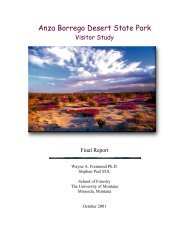Final Mitigated Negative Declaration and Response to Comments
Final Mitigated Negative Declaration and Response to Comments
Final Mitigated Negative Declaration and Response to Comments
Create successful ePaper yourself
Turn your PDF publications into a flip-book with our unique Google optimized e-Paper software.
mouth of Emerald Bay. Creating noise or visual disturbance during sensitive periods of the<br />
breeding season could result in impacts <strong>to</strong> this species.<br />
Osprey (P<strong>and</strong>ion haliaetus). The osprey is a TRPA threshold species. They are a migra<strong>to</strong>ry<br />
species <strong>and</strong> are present during the breeding season, April 1 through August 15. They build<br />
large stick nests in tree<strong>to</strong>ps or snags in open forests within fifteen miles of water used for<br />
foraging (DFG 2008). Ospreys are known <strong>to</strong> nest in Emerald Bay SP, including near the<br />
proposed project area. No habitat suitable for this species would be altered by project<br />
activities; however, project activities during the breeding season could impact this species.<br />
Ospreys have high nest site fidelity <strong>and</strong> selectively choose nesting locations with a clear view<br />
of the surrounding area. Creating noise or visual disturbance during sensitive periods of the<br />
breeding season could result in impacts <strong>to</strong> this species.<br />
Great Basin rams-horn (Helisoma newberryi). This species is known <strong>to</strong> occur in Lake Tahoe.<br />
These snails burrow in<strong>to</strong> soft mud of larger lakes <strong>and</strong> slow rivers. The project area consists of<br />
rock or cobble <strong>and</strong> there are no soft, muddy habitat types with slow moving water in proximity<br />
<strong>to</strong> project activities. Because typically suitable habitat for this species does not occur in the<br />
project area, impacts <strong>to</strong> this species are expected <strong>to</strong> be less than significant.<br />
Lake Tahoe benthic s<strong>to</strong>nefly (Capnia lacustra). This species is known <strong>to</strong> occur in Lake<br />
Tahoe at depths of 95-400 feet. Project activities will not occur in deep water areas <strong>and</strong> will<br />
not impact suitable habitat for this species.<br />
Benthic invertebrates- Although these animals are not listed as sensitive species, the benthic<br />
animal community in Lake Tahoe is an important component of the ecosystem. Whittmann et<br />
al. (2011) found that benthic barriers resulted in 100% mortality <strong>to</strong> Asian clams (AC) after 28<br />
days, <strong>and</strong> resulted in 70-95% of <strong>to</strong>tal macroinvertebrate diversity reduced. Most notable was<br />
the less severe impacts <strong>to</strong> native species including the pea clam (Pisidium spp.), with no<br />
significant impacts seen in one test plot. Lesser impacts <strong>to</strong> native macroinvertebrates would<br />
potentially allow a pool for recolonization. While the barriers reduce diversity of native<br />
macroinvertebrates in the short term, the alternative of allowing the AC populations <strong>to</strong> exp<strong>and</strong><br />
would potentially exclude native macroinvertebrates from the larger system in<strong>to</strong> the future.<br />
The infestation in Emerald Bay has already exp<strong>and</strong>ed over 40% in size since the initial survey<br />
in 2009. Treatment of approximately 5.5 acres out of the 870 (.6%) acres included in the<br />
underwater park would result in less than significant short term impact <strong>to</strong> this community, with<br />
potential substantial long term benefits.<br />
Lahontan Cutthroat Trout (Oncorhynchus clarkia henshawi). Researchers are in the process<br />
of reintroducing the Federally Threatened Lahontan cutthroat trout in<strong>to</strong> Lake Tahoe <strong>and</strong><br />
Emerald Bay <strong>and</strong> moni<strong>to</strong>ring survival <strong>and</strong> life his<strong>to</strong>ry as well as providing a recreational fishery.<br />
These fish are obligate stream spawners so deployment of benthic barriers is not expected <strong>to</strong><br />
impact potential spawning habitat. A combination of fac<strong>to</strong>rs is presumed <strong>to</strong> have led <strong>to</strong> the<br />
extinction of Lahontan cutthroat trout from Lake Tahoe, with the introduction of non-native<br />
species perhaps being the primary fac<strong>to</strong>r. Asian clams are a non-native species that<br />
negatively impact native species <strong>and</strong> removal of these clams from a target reintroduction area<br />
is not anticipated <strong>to</strong> negatively impact reintroduced Lahontan cutthroat trout.<br />
Asian Clam Control Project IS/MND<br />
Emerald Bay State Park<br />
California Department of Parks <strong>and</strong> Recreation<br />
29
















